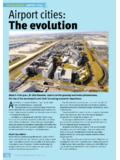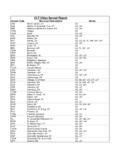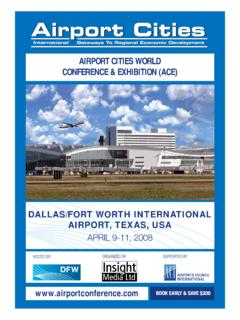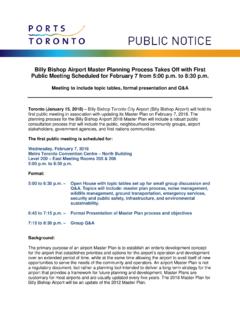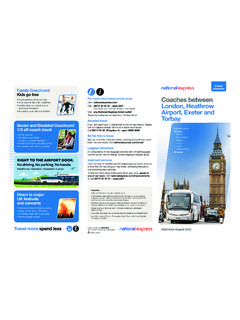Transcription of Morgantown People Mover – Updated Description
1 Steve Raney & Stan Young Page 1 of 12. Morgantown People Mover Updated Description Submission Date: November 15, 2004. TRB 2005 Reviewing Committee: Circulation and Driverless Transit (AP040). Word Count: 4,251 + 8 figures * 250 = 6,251. Paper presented at the Transportation Research Board Annual Meeting, Washington, , January 2005. This paper has been revised in accordance with the TRB peer review process ending November 15, 2004. Steve Raney Cities21. 1487 Pitman Ave., Palo Alto, CA 94301. (650) 329-9200. Stanley E. Young, , Advanced Technology Research Engineer Kansas Department of Transportation 2300 Van Buren Street Topeka, Kansas 66611. (785) 296-6959. Steve Raney & Stan Young Page 2 of 12.
2 ABSTRACT. The Morgantown People Mover is a five-station Automated Group Rapid Transit System (AGRT). This paper reviews history and operating principles, providing an Updated Description . Compared to previous papers, new contributions include: depiction of complex station design and station operations; GIS. alignment map; Description of moving point synchronous control; and explanation of three operational modes: demand, schedule, and circulation, with special emphasis on peak period operations. INTRODUCTION. The automated People Mover (APM) constructed in Morgantown , West Virginia in the 1970's was constructed as a demonstration of the Personal Rapid Transit (PRT) concept.
3 PRT is defined as an automated, demand-responsive, direct origin-to-destination transit service based on a fleet of small vehicles. Morgantown succeeded in demonstrating most of the tenets of PRT, but since the vehicles have capacity to hold 21 People , which is large in comparison to most PRT concepts, transportation theorists frequently refer to the Morgantown system as an example of Automated Group Rapid Transit. In this paper, to avoid confusion and debate, the Morgantown APM system is referred to simply as the Morgantown People Mover (MPM). The objective of this paper is to review the history and basic operating principles of the MPM. Since the MPM has been in continuous operation since 1979, it presents a valuable opportunity to assess the effectiveness of an APM to meet the travel needs of a university community consisting of approximately 50,000 People .
4 The dominant form of public transportation in the United States over the past forty years has been the privately owned vehicle operating on a system of streets and highways. The MPM was the result of the major federal initiative in the United States to address public transportation needs in an innovative fashion apart from simply funding expansion of traditional transportation infrastructure. It is the goal of this paper to provide the necessary background on the MPM to initiate discussion on the proper means to build upon the concepts demonstrated and lessons learned at Morgantown . HISTORY. West Virginia University's late 1960's expansion produced two campus areas, separated by one mile and served by only two hilly roads.
5 Buses shuttled students back and forth between campuses, but, by the early 1970's, the roads would sometimes experience severe traffic congestion. At one point, to reduce daily student travel, the university was forced to require students to take classes at only one of the two campuses. The MPM solved this traffic congestion problem. (1). The MPM was funded as an Urban Mass Transportation Administration (UMTA) demonstration project in the early 70s. The demonstration project was the result of several system studies in the late 1960s whose objective was to determine the most effective method of meeting the public transportation challenge in our growing cities and metropolitan areas.
6 These studies identified the basics tenets of on- demand, personalized, origin-to-destination service as the basis to construct effective public transit systems into the 21st century. Initial prototype work performed by the Aerospace Corporation combined with private investment fueled the enthusiasm for this new type of transit, commonly referred to as PRT, during the late 1960s. Congress responded by ear-tagging money for a demonstration project at the Morgantown campus of the West Virginia University (WVU), the home state of Senator Byrd, an influential politician during that era. Morgantown is a community of approximately 30,000 residents (Year 2000 census). The enrollment at the University is approximately 19,000 students, with 7,500.
7 University staff. Steve Raney & Stan Young Page 3 of 12. What started out as a demonstration project estimated to cost between $15 to $20 million dollars quickly turned into a political chess piece in the presidential election campaign of 1972. Pressure applied by the administration to complete the project before the next election combined with the uncertainty of any new technology resulted in an approximately $130M system which took nearly a decade to complete. Though the MPM system proved challenging to engineer, the system has been in passenger operation for 26 out of 27 years starting from 1976. The system was shut down for expansion during 1979. The MPM was advanced for its time and pioneered a number of new technologies.
8 A number of other advanced transit systems were under development in the 1970's, including the German Cabintaxi system, the Japanese CVS system, the Kobe Rapid Transit System, Rohr Corporation's ROMAG system, and the Dallas Fort Worth Airport LTV AirTrans system. Of these, only the AirTrans system was brought into public service. Also during the 1970's, a series of less advanced APMs and monorails either were already in operation or came into in operation: two Disney WED APMs, five UMI. monorails at amusement parks, California State Fairgrounds APM, Barrett Houston Airport APM, SeaTac airport APM, Tampa Airport APM, and Westinghouse Busch Gardens APM. Compared to these other systems, MPM's world "firsts" for innovations being put into public service include: First fixed guideway transit switching via in-vehicle switching, rather than a track switch.
9 First "demand mode" fixed guideway transit service. First transit control system whereby central control communicates to vehicles, providing automated vehicle control, via inductive wire loops embedded in the guideway. First "moving slot" control system. First automated re-distribution of empty vehicles to match predicted demand These system features are explained in the body of this paper. The excessive cost of the MPM, which is roughly $319 million in 2004 dollars, is a frequently cited as a detractor. The cost analysis for the MPM should be used with caution. As a demonstration project the system did not have cost-effective construction and operation as its number one objective, rather it was seen as a proof-of-concept for future systems.
10 The risk involved with new technology combined with the political pressure applied to complete the project in record time also inflated the system cost. Steve Raney & Stan Young Page 4 of 12. Figure 1. Morgantown Alignment: More than 3 miles of two-way guideway from Walnut Station to Medical Station. GIS data courtesy of City of Morgantown Utility Board GIS Department. Figure 1 illustrates the layout of the MPM that connects the various activity centers of the university and community along a five-mile long corridor. Today, the system carries roughly 15,000 passengers per day, for a total of about million passengers per year. The system continues to operate in nearly the same configuration as it was inaugurated in the 1970's.
